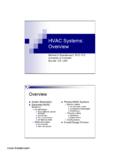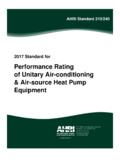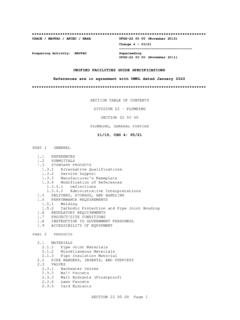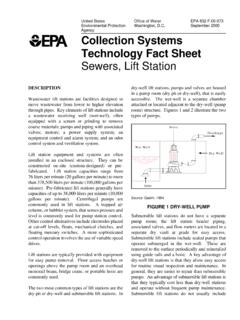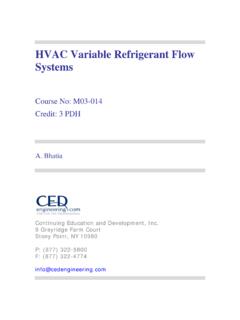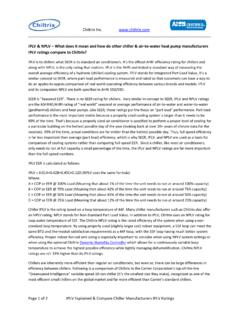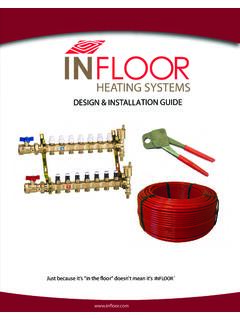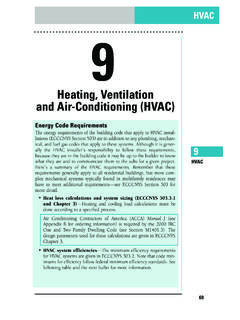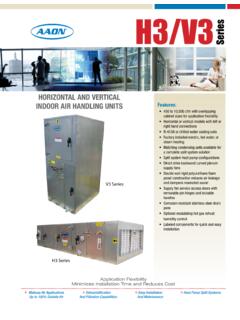Transcription of MVR (Mechanical Vapour Recompression) Systems for ...
1 Technical Information Document MVR. (Mechanical Vapour Recompression). Systems for Evaporation, Distillation and Drying Technical Information Document 2019. MVR (Mechanical Vapour Recompression) Technical Information Systems for Evaporation, Distillation and Drying Document Introduction Mechanical Vapour recompression (MVR) Systems (also called MVR blowers) recover and reuse energy normally lost through evaporation. Because of the ability to use and upgrade wasted energy, MVR can significantly increase the efficiency of industrial heating and evaporation processes.
2 They achieve this by recompressing Vapour for reuse as a heat source for the same process from which the heat was recovered. MVR technology is well established in New Zealand's dairy sector for the evaporation of milk. This is the most important example of high efficiency, open cycle heat pumps in New Zealand's process industries. Traditionally, water removal from liquid milk prior to spray powder drying was achieved using multi-effect evaporators with five to six stages, or effects, to improve thermal efficiency.
3 The heat input came from Low Pressure (LP) steam let down from cogeneration steam turbines, while input High Pressure (HP) steam usually came from coal-fuelled boilers. The dairy industry began using gas at a large scale in the late 1990's and at this point the HP steam was produced from steam generators heated by the waste heat from cogeneration gas turbines. Thermal Vapour Recompression (TVR) steam ejectors were introduced to further improve the thermal efficiency of the evaporator train. In this system, Intermediate Pressure (IP) steam mixes with waste low pressure steam (under vacuum).
4 From the evaporator in the TVR steam ejector. This TVR technology has also matured and is widely used at the finishing stage(s) in the milk evaporation process. The breakthrough with MVR technology came with the use of steam compressors which elevate the pressure of the waste steam from the evaporator so that it can be re-used by condensing at a higher saturated temperature to drive the evaporation cycle. Many operational and process cost advantages were anticipated from this electro-technology including less residence time with improved product quality and lower wastage from cleaning as well as energy and GHG emission reductions1.
5 Subsequently, MVR high- speed blowers have replaced the compressors and MVR evaporator technology has become the evaporator of choice for all new greenfield powder plants. There are over 100 MVR blowers on milk evaporators in the New Zealand dairy industry. The New Zealand dairy industry has led the way with this energy efficient technology. However, other process industries have been much slower to apply the benefits of MVR technology. New advances in multi-staged arrangements and in small and higher speed MVR blowers are opening up new retrofit opportunities to continue to gain these energy efficiency benefits.
6 The focus of this technical note is on MVR technology for evaporation. There has been some progress in transferring MVR. technology to drying, for example in superheated steam drying and heat recovery from waste steam applications. Multi- staging of MVR blowers also allows retrofit for distillation tasks which expands the opportunities for businesses to capitalise on New Zealand's renewable electricity resources. 1 The main operational advantage was the ability to use three MVR evaporators, with two on product and one being cleaned, so the large spray dryers could be run continuously for 30 days before a shutdown for cleaning.
7 EECA commissioned Strata Energy Consulting and Efficient Energy International to produce this document which is one of a series on electrical heating. The Energy Efficiency and Conservation Authority (EECA) endeavours to the best of our ability and knowledge to ensure that the information provided is accurate and current. However, we cannot accept any liability for the accuracy or content of material. The contents of this report should not be construed as advice. Readers should take specific advice from qualified professionals before undertaking any action as a result of information contained in this report.
8 Reference to a specific commercial product, process or service, whether by trade or company name, trademark or otherwise, does not constitute an endorsement or recommendation by the New Zealand Government or EECA. The information provided does not replace or alter the laws of New Zealand, or later any other official guidelines or requirements. PAGE 2. MVR (Mechanical Vapour Recompression) Technical Information Systems for Evaporation, Distillation and Drying Document Technical features Overview of evaporation processes The three types of evaporators found in the New Zealand process industries are illustrated in Figure 2.
9 The arrows in the diagram correspond to the magnitude of the mass flows, with red indicating input energy or steam into the system. The dilute process stream (A) is fed into tubes in the falling film evaporator. The concentrated stream (B) is separated from the evaporated Vapour (C) which, for a dairy MVR evaporator, is steam under vacuum. The steam from the boiler (D) drives the heat transfer and the steam condensate (Cc) is removed2. In a direct heated evaporator, the Vapour (C) normally feeds the next stage or effect (not shown for simplicity).
10 In a TVR system, part of the evaporated Vapour is mixed with the feed steam (D) in the thermal ejector (F). In a MVR system, the blower (G) raises the pressure and temperature of the evaporated Vapour (C) to drive the heat transfer from in the evaporator. The steam (D) in the MVR evaporator is used as start-up energy. Direct heated TVR MVR. Key: A = Process stream, milk at 12% total solids B = Concentrated stream, concentrated milk at >40% total solids C = Evaporated Vapour steam as water Vapour from the milk Cc = Condensate from the steam driving the heat transfer in the evaporator D = Steam required from boiler only used at start up E = Electrical power to MVR blower F = Thermo ejector for the TVR.
